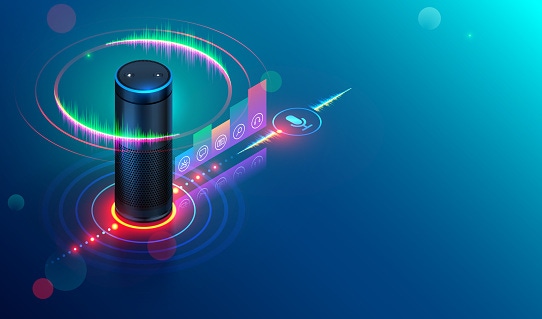Voice-activated devices have helped fuel IoT adoption. The long-term ramifications for application development could be considerable.
March 24, 2020

By Scott Robinson
While the average person speaks about 15,000 words a day, increasingly they’re speaking those words to machines. Smart speaker adoption has been rapid, with voice assistants such as Alexa setting the pace. Today 53 million people in the U.S. already own at least one. The number of voice assistants in U.S. homes has doubled since 2018 (to reach 25 million) and will increase to 275 million by 2023. That amounts to 1,000% growth in only five years, according to Juniper Research.
Smart speakers aren’t the only voice-command devices out there. Smart speaker apps run on smart phones and tablets as well.
One vendor, for example, offers a device-agnostic voice control platform that can be customized to a company or industry vocabulary and operate offline. Another offers a smart TV equipped with a virtual assistant. A third provides voice interaction in manufacturing and construction environments, allowing workers hands-free access to relevant knowledge on demand.
Internet of Things (IoT) voice control is also pushing automobiles to the forefront of IoT adoption. Cars are now integrated with mobile apps to enable voice-activated commands while driving. Gartner puts adoption at 20% by the end of this year.
Voice-Activated Technology at Home, at Work
While voice-activated technology has hastened IoT’s introduction to the home environment, voice interfaces have experienced slower adoption in the workplace. According to Globant’s 2018 Voice-Activated Technology Report, there is a significant gap between personal use of voice command devices and business use. While 72% of senior employees reported using voice-activated technology in their personal lives on a weekly basis, only 31% use it at work. And 73% of companies surveyed view voice-activated technology as valuable to the enterprise but haven’t taken steps to adopt it into their processes.
According to a 2018 report by Pindrop, 85% of companies surveyed plan to deploy voice-activated technology for customer interaction. Of managers responding, 88% say they believe voice-activated technology can create competitive advantage, with 57% agreeing it would make the enterprise more efficient.
In addition, the initial deployment of voice-activated technology in the enterprise tends to focus on cloud-based customer support, accessible via smart phones and laptops, rather than dedicated IoT hardware. Other industries such as transportation and manufacturing require edge computing to provide the necessary bandwidth for voice-activated technology. As a result, adoption of voice-activated technology will likely be slower, because deployment of the technology in those environments requires additional investment in edge servers to boost processing bandwidth to acceptable levels.
Leveraging the Smart Speaker
Enterprises can trim the cost of voice-activated technology by piggybacking on what’s available instead of building voice-activated apps from scratch or paying for a pricey vendor system, simply pay Amazon to add a new skill to Alexa.
When Amazon first released Alexa in 2016, it had a catalog of 130 skills; as of September 2019, the catalog has grown to more than 100,000 skills. Amazon will create custom skills for a fee, and also offers the Alexa Skills Kit, a collection of application programming interface, tools and sample code which third-party developers can use to create their own. These new skills can be made available to any person or company using Alexa for voice-command functionality.
This strategy enables a low-cost and rapid adoption of voice-activated IoT in the enterprise, and it bypasses the need for edge resources. This may limit its application, but it gets the technology in the door and integrates it into some business processes.
A great example of how the skills kit and Alexa can create new voice-activated technologies is KidsMD, a Boston Children’s Hospital app. Parents can ask questions about a child’s illness or injury for real-time information about treatment, procedures or medication.
The hospital also built an Alexa app that a gastroenterologist uses in the operating room to voice-activate an endoscopic camera. In the ICU, nurses use an app that provides the necessary information for drawing the correct amount of blood, saving 15–30 minutes per patient; and there’s a version of the KidsMD app that provides information on procedures and troubleshooting for hospital personnel.
Orbita, which produces an assortment of virtual health assistants, has generalized these capabilities and made its platform available in many mediums – smartphones, tablets, smart speakers – empowering consumers to locate medical resources, order medication, make appointments, understand lab results and set self-care reminders. Its OrbitaASSIST IoT is a virtual bedside assistant that facilitates patient-provider communication, reducing wait times, optimizing clinical team management and improving the patient’s experience.
New Types of Voice-Activated Apps
All of these approaches to integrating voice-activated technology into consumer and professional processes hasten the adoption of IoT in general; but voice-activated technology is also driving the development of new processes.
One exciting application of voice-activated technology is in devices for the visually impaired, allowing them to interact with the world in ways they previously couldn’t. Another is the screenless wearable (wearables have done much to advance public awareness of IoT), which typically requires a mobile application to display its data to the user; with voice-activated technology, it can respond directly.
Perhaps most game-changing is the potential of language translation. Voice-activated technology in IoT, with AI providing the translation, will remove many barriers in business and improve personal quality of life. In the workplace, real-time translation and IoT devices that can overlay it will make multi-lingual teleconferencing more efficient. In the home, children adopted into families who don’t speak their native language can interact with their new family members with a smart phone using a translation app (like Apple’s iTranslate) and earbuds.
IoT is spreading fast, and with voice-activated technology, it’s spreading faster. Today’s young children will not remember a time when cars, homes and the objects around them didn’t talk.
You May Also Like



.png?width=300&auto=webp&quality=80&disable=upscale)


.png?width=300&auto=webp&quality=80&disable=upscale)